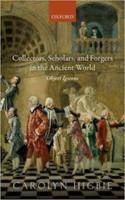
OUP (2017) h/b 276pp £65 (ISBN 9780198759300)
Carolyn Higbie’s research into classical Greek attitudes to the past is well known. Here she is more ambitious in looking at three related categories: collecting, studying and forging during classical antiquity. The vast and varied amount of ground covered means that this is not a book for beginners.
The four major chapters concentrate on ‘Collectors, Collecting, and Collections’, ‘Visual Forgeries’, ‘Textual Forgeries’, and ‘The Forgery of the Past’. The author notes that ‘ancient attitudes towards originals, copies, and versions are complex and not yet well understood’ (p. 101). The reasons for collecting in the ancient world varied over time, from objects that were erected in temples and sanctuaries to those that later graced libraries and gardens—mainly for prestige and pretension. Cicero is a prime example. But, as time went by, more attention came to centre on named artists (e.g. Myron and Praxiteles) with an interest in collecting and forging art works.
With regard to texts, H. points out how the Hellenistic period became a world of written texts but ‘once a writer made his composition available to the public … he essentially lost control of it’ (p. 155)—it was in the public domain. It is amusing to read that Galen did not even possess copies of some of his lectures, until they were sent to him for correction (p. 159). Forgers had to be scholars, concentrating on the style of the author, the form of individual letters, the appearance of the document, etc. Failure might carry a heavy penalty. As is well known, Onomacritus was expelled from Athens by Hipparchus for inserting an oracle into Mousaeus’ collection of oracles (Herodotus 7.6.3-4).
In chapter 4 (‘The Forgery of the Past’) the major authors are the antiquarians Pliny the Elder, Pausanias and many lesser lights, with the paradoxographers and their interest in oddities and hoaxes, big bones, and fossils, with such stories as the elephant that learned to write Greek letters (p. 198).
Each chapter is framed by examples of post-classical collecting and forging that highlight the more modern approaches to the practices, e.g. items from the New York Times, Charles Townley, David Garrick and Shakespeare, and the Piltdown Man. Not all these digressions work equally well and tend to interrupt the flow. The book is illustrated with 8 colour plates and 31 black-and-white figures. The coloured images are mainly post-classical, while the black-and-white images (with either brief or unbalanced information in the captions) centre on well-known copies of classical statues, accompanied by inscriptions, painted pottery, coins, and precious objects, together with a scattering of post-classical items. As with the framing sections, I feel that they do not all do justice to the essence of H.’s impressive researches.
Brian Sparkes
